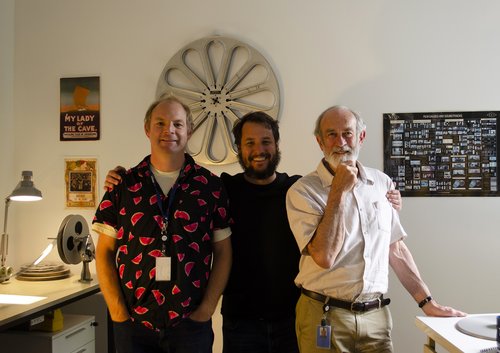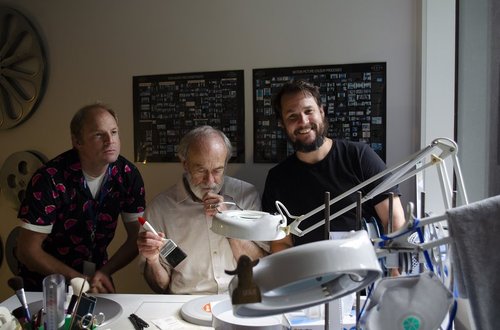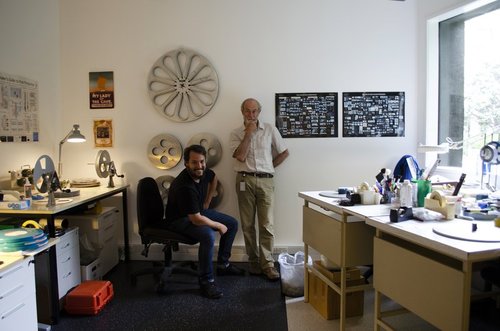
The film team are a bunch of experts. They put in hours of hard work to get the best preservation results from archival film. A range of different film formats are assessed, documented, possibly repaired, scanned and then stored in a vault. I spoke with three of the five team members, Kurt Otzen, Richard Falkner and Gareth Evans. We’ll check in with the two other members of the team – Leslie Lewis and Sara Pattison – in a future edition. The team have a variety of backgrounds and a mix of formal and on-the-job training.
Can you describe your job in a few words?
Kurt Otzen, Senior Film Archivist (Film Specialist) – The words that come to mind are patience, persistence, practicality, accommodation and dexterity – as a film archivist my fingers have to take great care.
Richard Falkner, Senior Film Archivist (Film Scanning) – I wrote down fascinating, precise, varied, evolving and then I couldn't decide between puzzling and challenging cause sometimes it’s a jigsaw. You might have several versions of something, none of which might be complete. You have to work out which is which and make a complete version with the best available.
Gareth Evans, Senior Film Archivist (Colourist) – Dark, lonely. (Gareth is a film grader and needs to work in a dark room) Puzzle is a good one. It’s also technical.
Hero Image: Richard Falkner, Gareth Evans and Kurt Otzen. (Photo by Leslie Lewis)

Richard Falkner, Kurt Otzen and Gareth Evans. (Photo by Leslie Lewis)
Do you have any favourite items from the collection?
Kurt – Across the Mountain Passes and Luna Park are two I like very much. Also Mount Eden School because it was one of the more difficult ones that we managed to get through. It was one of the first things that we had digitized, though not in our lab. Free Radicals by Len Lye was another early digitization. Another favourite is Auckland from the Skies.
Gareth – I agree with a lot of those, especially things like Luna Park and Across the Mountain Passes because that's one that I'm doing a lot of work on – beautiful hand-tinted stuff. Patu! is another one I really like. And Snows of Aorangi.
Richard – Each of the personal records are unique and the collection is fairly unique to Ngā Taonga. In particular the Hilda Brodie Smith collection and the McLaren collection. The Bruce McLaren collection in particular is a massive and interesting insight into his actual life. Any Pathé colour stuff is great and so is Patu! The Whetton collection. We have fragments from Sexus, which is from the 1970s. It's a background projection for a dance show. It has this fascinating decomposition of the splice which has started to leach into the emulsion – it’s created a new kind of work in a strange way, it’s incredibly beautiful.
You must watch a lot of stuff for quality control?
Gareth – Yes, we must be up there for the most Kiwi films watched. I think we watched Pallet on the Floor like 20 times without sound.
Richard – Death Warmed Up was cool.
Have you had any really memorable events during your work here?
Kurt – In which of the 31 years I’ve been here? I’ve worked at four locations. Lately the 85 frame enlargements for Chris Pugsley's book Camera in the Crowd, which was intense, almost fun, and certainly memorable.
Richard – Getting to know the scanners and beginning that whole workflow for me has been huge. Then moving them all recently (to the National Library), which was slightly nerve-racking, but went without a single hitch in the end.
Gareth – Having a tent (the film grading suite at Taranaki St was one end of a room enclosed with large blackout curtains), working in a tent and then escaping the tent and then missing the tent is the strangest twist of my career. I didn't see that coming. Working in a tent was hilarious, especially explaining it to my kids. I liked having that theatrical swishiness when I appeared through the curtains.
How do you see your work connecting with the rest of the Archive?
Richard – We sort of take things that physically exist, but aren't immediately accessible and we make them into a shape that is a lot more accessible I guess - as accessible as possible.

Gareth Evans and Kurt Otzen. (Photo by Mishelle Muagututi'a)
Could you give a quick background on how you've come to be working here?
Kurt – I couldn't, and I can’t find my way out. I had my job interview in 1988 with Jonathan Dennis at the old Film Unit in Avalon. After this I had trouble locating the exit. Our late colleague Jane thought that was amusing and for 30 years she reminded me. I don’t have a film background, but I’d often worked in photography. I learned on the job and still am.
Gareth – I was at Park Road Post Production doing a lot of work for Ngā Taonga and then production on The Hobbit finished and I ended up here. I've got an Honours degree in film and philosophy and I trained at Park Road as part of their trainee programme – I was one of their last trainees. I worked my way from the lab to digital and trained as a colourist.
Richard – I'm more like Kurt in that I don’t have a background in film. I started in the cafe like several other staff here. I got an opportunity to work with Kurt and Louise (McCrone, Group Manager Collection Services) doing simple film handling and then developed my physical film preparation skills. The opportunity to get more into the digitisation side came up, which has been a massive learning curve.